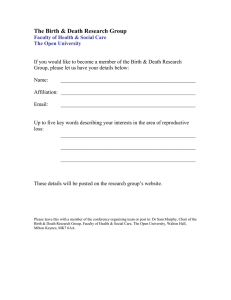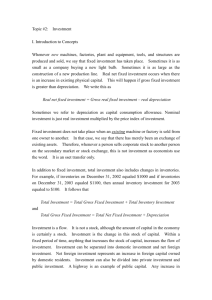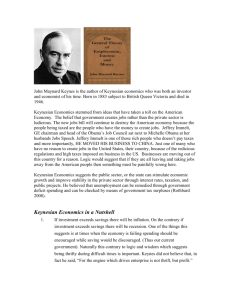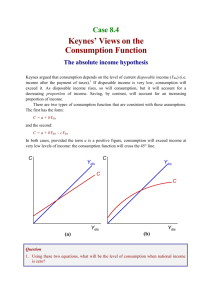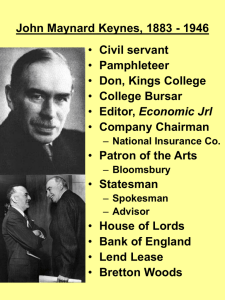Keynes april konference 2008
advertisement
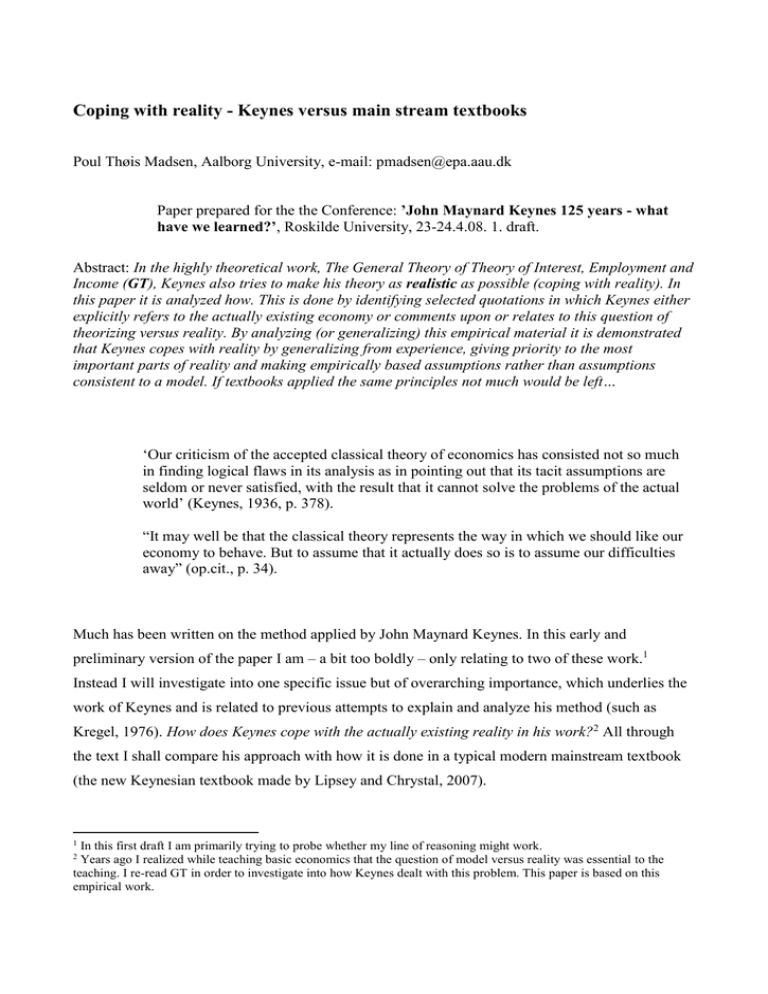
Coping with reality - Keynes versus main stream textbooks Poul Thøis Madsen, Aalborg University, e-mail: pmadsen@epa.aau.dk Paper prepared for the the Conference: ’John Maynard Keynes 125 years - what have we learned?’, Roskilde University, 23-24.4.08. 1. draft. Abstract: In the highly theoretical work, The General Theory of Theory of Interest, Employment and Income (GT), Keynes also tries to make his theory as realistic as possible (coping with reality). In this paper it is analyzed how. This is done by identifying selected quotations in which Keynes either explicitly refers to the actually existing economy or comments upon or relates to this question of theorizing versus reality. By analyzing (or generalizing) this empirical material it is demonstrated that Keynes copes with reality by generalizing from experience, giving priority to the most important parts of reality and making empirically based assumptions rather than assumptions consistent to a model. If textbooks applied the same principles not much would be left… ‘Our criticism of the accepted classical theory of economics has consisted not so much in finding logical flaws in its analysis as in pointing out that its tacit assumptions are seldom or never satisfied, with the result that it cannot solve the problems of the actual world’ (Keynes, 1936, p. 378). “It may well be that the classical theory represents the way in which we should like our economy to behave. But to assume that it actually does so is to assume our difficulties away” (op.cit., p. 34). Much has been written on the method applied by John Maynard Keynes. In this early and preliminary version of the paper I am – a bit too boldly – only relating to two of these work.1 Instead I will investigate into one specific issue but of overarching importance, which underlies the work of Keynes and is related to previous attempts to explain and analyze his method (such as Kregel, 1976). How does Keynes cope with the actually existing reality in his work?2 All through the text I shall compare his approach with how it is done in a typical modern mainstream textbook (the new Keynesian textbook made by Lipsey and Chrystal, 2007). 1 In this first draft I am primarily trying to probe whether my line of reasoning might work. Years ago I realized while teaching basic economics that the question of model versus reality was essential to the teaching. I re-read GT in order to investigate into how Keynes dealt with this problem. This paper is based on this empirical work. 2 2 This comparison serves two purposes. In this context the textbook represents a mainstream attempt to cope with reality and secondly, to some extent the textbook also represents what mainstream economists think we ‘know’ about the working of the real economy.3 Hence, this comparison works as a prism highlighting the importance of the contribution made by Keynes in this respect. In what follows I shall firstly introduce the question of theory (model) versus reality, but in the main bulk of the paper the way of coping with reality in GT is analyzed in some detail. Finally, some concluding thoughts are presented. 1. Briefly on theory versus reality I order to put this discussion into perspective it is necessary to introduce the subject briefly. It is generally accepted by social scientists that we need theories to grasp reality. On the other hand there is no general agreement among economists or social scientists in general on what reality is and hence on how is could and should be analyzed. There is an outspoken tendency among economists to be die-hard positivists believing that the economic reality is out there and can me measured and modelled and that is about it. Textbooks present imperfect attempts to model and theorize reality. Textbooks give the reader the impression of a science that is progressing gradually by ever constant attempts to refine and improve its representations of reality. Gradually theory is implicitly seen as getting ever closer to grasping the complexities of reality. According to the underlying logic of this only slightly caricaturized picture, the problem of theory versus reality might have been an issue of importance yesterday but it is now gradually disappearing as an issue of relevance. I would rather suggest that (economic and other) theory has to be open and sufficiently flexible to account for a reality which changes on a current basis.4 Henceforth, we need to change and adapt the way we analyze reality on a current basis too. Furthermore, textbook economics has in my mind an arms length approach to reality – as a logical consequence of the underlying notions of rationality and equilibrium - which have more to do with abstract deductive theorizing than actual reality. 3 The relation between textbook economics/neoclassical economics and research within economics is not straightforward and is worthwhile discussing (see e.g. Gintis, 2007): how and to which extent do textbooks reflect research? In order to avoid the criticism forwarded by Gintis I have chosen a mainstream textbook as a convenient and homogenous scapegoat and measuring rot. 4 The organizer of this conference Jesper Jespersen (2007) pursues the same line of thinking. 3 The question of method versus reality is the key question in economics – in relation to theorizing but also in relation to the teaching in economics (see Madsen, 2007). Keynes gave us a method to theorize reality without killing essential parts of it as textbook economics often tends to do. This is what I intend to demonstrate in the following. 2. How does Keynes relate to reality in General Theory? One thing that is striking when one compares GT to traditional textbooks of economics is that in textbooks the relation between theory and reality has been settled. Generally, it is implicitly assumed that we know how the economy works and this is what is described by theory. Now and then reality – that is histories from the real world - enters the picture illustrating some of the theoretical arguments made but basically theory and reality do have a very limited mutual impact on each other.5 One could believe that this interaction was far more outspoken when the theories were originally developed but it is important to acknowledge that already at that time large chunks of economic theory was to quote ‘simply made…up’ (Bergman, 2005, p. 56) - that is on a completely deductive basis In contrast to textbooks we witness in GT a theory in the making. GT is an open laboratory in which Keynes tries in an open discussion to organize his thoughts on economic issues he considers as being of importance. In doing this he relates to previous theory and the empirical reality of yesterday and the problems of (his) today and he attempts to relate this knowledge (old theory and old and new reality) to his new way of thinking. He persistently tries to make his argument consistent. At the same time he repeatedly points to the limits to his arguments. In this sense GT is an open and very transparent on-going discussion. But this is a very general picture. When reading GT the first and dominant impression is the absence of the real world. It is really a theoretical work or as Keynes puts it:”its [GT] main purpose 5 In Lipsey and Chrystal (2007) one can find a very interesting and exceptional example of at least partial adaptation of theory to actual reality. For years the application of the ISLM model in textbooks led to the following interpretation of actual monetary policy: the interest rate is changed by changing the amount of money supplied. In the 2007 version it is explicitly acknowledged that monetary policy is conducted by setting the short interesting rate while the money demand and supply adapt to changes in the interest rate. In this way the money supply has become partly endogenized – as suggested by post-Keynesians for decades. Only partly as this adaption has not been quite digested by the textbook authors; it is, hence, still assumed that when prices increase the real money supply will decrease accordingly (rather than letting the money supply expand endogenously and hereby automatically satisfying the increased demand for money due to the higher prices). 4 is to deal with questions of theory, and only in the second place with the applications of this theory to practice” (p. xxi). As a consequence one finds very few references or indications of a reality outside the theory presented in the book. Basically, Keynes is concerned with constructing a model rather than applying or relating it to the real world. In other words one has to analyze GT in order to ‘find’ the reality. But it is there – between the lines, in passing and in some few instances reality is explicitly mentioned and used as a platform for theorizing. By analyzing GT one can identify a number of causalities and distinct features of actual capitalism Keynes seems to think are of some general importance. Nine of these stylized facts are presented in the following and several of them are well-known. Most of these relates to typical capitalistic and industrialized countries while some of them mainly relate to the dominant economy USA. Note when Keynes talks about reality he often uses the word ‘fact(s)’. The nine points are structured according to page number rather than importance. 1. “there will always exist in a non-static society a proportion of resources unemployed ‘between jobs’” (p.6). In other words search unemployment is an empirical fact. 2. In general he relates to the working of the actual labour market rather than labour markets characterized by perfect competition, which tend to dominate modern days textbooks: ‘in view of the fact that the population generally is seldom doing as much work as it would like to do...’ (p.7) ‘relates to the actual attitude of workers towards real wages…’ (p.8). “Whilst workers will usually resist a reduction of money wages…the contention that the unemployment which characterises a depression is due to a refusal by labour to accept a reduction of money-wages is not clearly supported by the facts…” (p.9). In other words: some degree of involuntary unemployment is the rule rather than the exception in any capitalist economy and workers will tend to resist reductions in money wages but this lack of flexibility in nominal wages does not – as assumed by textbooks – explain the existence of unemployment – as this is not ‘clearly supported by the facts’. 3. Keynes states the following about the concept of effective demand: “For professional economists, after Malthus, were apparently unmoved by the lack of correspondence between the results of their theory and the facts of observation; -a discrepancy which ordinary man has not failed to observe, with the result of his growing unwillingness to accord to economists that measure of respect which he gives 5 to other groups of scientists whose theoretical results are confirmed by observation when they are applied to the facts…having left this world for the cultivation of their gardens ” (p. 33). The concept of effective demand is hence also based on ‘the facts of observation’ – it is actually in some sense out there. 4. Consumption is assumed to grow less than income as this is an ‘actual fact’ (p. 118). 5. “The state of confidence, as they term it, is a matter to which practical men always pay the closest and most anxious attention” (p. 148). In other words this key concept in GT is out there and makes sense to businessmen. This is easily confirmed by reading any business news paper or journal. 6. “With the separation between ownership and management which prevails to-day and with the development of organised investment markets, a new factor of great importance has entered in, which sometimes facilitates investment but sometimes adds greatly to the instability of the system” (p.150-51). Again Keynes relates to a real life phenomenon which to this very day plays a crucial role in explaining the working of any capitalist system. 7. “When the capital development of a country becomes a by-product of the activities of a casino, the job is likely to be ill-done” (p.159 – referring to the USA). This well known quotation does, hence, also relate to parts of empirical reality – and even more so today than in 1936! 8. One of Keynes’es greatest achievements was to change the understanding of the interest rate as being something natural or physical. Again he did so by actually observing how the interest rate behaves in real life. He did observe two related ‘facts’: that a lot of psychology is involved in determining how the interest rate behave and that one cannot rely on the interest rate in establishing equilibrium: “the rate of interest is a highly psychological phenomenon” (p. 202)…There are, however, several reasons, which taken in combination are of a compelling force, why in an economy of the type which we are accustomed it is very probable that the money-rate of interest will often prove reluctant to decline adequately” (p. 232). 6 9. In the following quotation he gives an overall view of his analysis of the general working of the actually existing economic system: “But the actual phenomena of the economic system are also coloured by certain special characteristics of the propensity to consume, the schedule of the marginal efficiency of capital and the rate of interest, about which we can safely generalise from experience, but which are not logically necessary. In particular, it is an outstanding characteristic of the economic system in which we live that, whilst it is subject to severe fluctuations in respect of output and employment, it is not violently unstable. Indeed it seems capable of remaining in a chronic condition of sub-normal activity for a considerable period without any marked tendency either towards recovery or towards complete collapse. Moreover, the evidence indicates that full, or even approximately full, employment is of rare and even short-lived occurrence…an intermediate situation which is neither desperate nor satisfactory is our normal lot…useful to consider what hypothetical psychological propensities would lead to a stable system” (p. 250). A number of important observations are made in this quotation. He characterizes his method in general terms: he ‘generalize(s) from experience’. In other words Keynes applies a qualitative method in the sense that he tries to identify the dominant qualities or the general patterns of then phenomenon under study – in this case the actually existing capitalistic societies. Secondly, he mentions one of the most basic features of the capitalist system as we know it: it is unstable but not violently so. Thirdly, he observes – once again - that full employment is an exception rather than the rule. In contrast in textbooks the economic system is assumed to - in the long run – to end up in a situation characterized by full employment. Full employment in textbooks is in this sense the rule rather than the exception. This is however an assumption or logical consequence of the construction of the theory – not something that follows from actually observing economic systems in ‘the long run’. Fourthly, Keynes also indicates that it does make sense to think about hypothetical ‘propensities’ – that is imagining how the economic system would have to be changed in order to produce full employment. And the underlying message is that this will not happen automatically by relying on market forces only. Hence, Keynes was of the opinion that it is possible to say something general about the actually existing capitalism and that is possible to have reality as a point of departure without drowning in a 7 complex reality.6 Keynes copes with this complexity by giving priority to the most important parts of reality, cf.: “This is not a complete catalogue of all the possible reactions of wage reductions in the complex real world. But the above cover, those which are usually the most important” (p.264, my emphasis). As for the making of assumptions – a necessary part of any economist’s toolkit – he states the following: “on plausible assumptions relating to the real world” (p.306). This is a crucial quotation indeed. Economists often make assumptions in order to make their models consistent. But assumptions as well as causalities have to be backed by empirical evidence – according to Keynes. By identifying the main characteristics and the most important causalities of the actually existing economic system and by making plausible assumptions Keynes is capable of ‘taming’ the real world (se also Kregel, 1976, p. 211). Reality in itself is too complex to cope with without generalizing and making plausible assumptions. One of the main problems of textbooks of economic is that all causalities and assumptions are presented on equal footing – none are presented as more well-founded or more important than others. Keynes on the other hand on a current basis discusses which causalities and assumptions are plausible (and why) and he is very careful in indicating when he makes some temporary assumptions for the sake of the argument. 3. What can we learn from Keynes concerning coping with reality? We have already learned a lot from Keynes despite the regrettable fact that so much has been forgotten in mainstream textbooks. But we can also learn something to which less attention has been paid. Without formulating it explicitly in his writing Keynes demonstrates a deep awareness of the subtle problems of how to analyse the actually existing economies – also known as the model versus reality problem. The message above could be condensed into three points. When making or creating economic theory we should: Bergman (2005) puts this fear of mainstream economists nicely: “Most economists apparently fear that the abandonment of the nonobservational method, and a plunge into research on the messy and multitudinous world of business behavior, might well leave us with just the latter” (p. 57). 6 8 a. generalize from experience b. give priority to the most important parts of reality c. make assumptions that relate to the real world. This might sound obvious and I guess non-economists would suppose that all economists would abide to these points. I would, however, argue that any textbook in economics would not pass this ‘test’. Large parts of textbooks consist of theory not ‘generalized from experience’, whole sections have nothing to do with reality (e.g. competitive markets) and assumptions are just made time and again without any empirical justification (firms maximize profits; agents are supposed to be rational, the economy is moving towards equilibrium, the long run actually ‘exists’ etc….). But the more general message we can learn from Keynes is that we cannot just apply theory already developed without any adjustments to the field under study. We have to let the chosen theoretical framework interact with the piece of reality which we want to analyze and adjust theory accordingly. Henceforth, theorizing and doing the empirical investigation are two sides of the same coin. As a consequence we also need to be much more disrespectful towards theory than economists are used to be. As for the possible advance in our common knowledge on how the economy actually behaves we have to identify theoretical core elements that seem to survive dramatic changes we have been living through inside and across nations and through history. Some of these core elements are some of the key concepts suggested by Keynes (such as efficient demand as also suggested by Kregel, 1976 and more recently Jespersen, 2007), but the same goes for a few of the key causalities we already operate with in textbooks. But what we actually know tend to – to quote Keynes - be drowned in textbooks in ‘a maze of pretentious and unhelpful symbols’ (p. 298). Taking reality seriously would hence lead to a very critical reading and revision of the textbooks on the market. Not much would survive such a reading. References Bergmann B.R. (2005), “The Current State of Economics: Needs Lots of Work”, in The Annals of the American Academy 9 Gintis, H. (2007), “With Enemies Like This, Neoclassical Economics Needs No Friends”, Review of Fullbrook (2007) (see Madsen, below), www.amazon.com/review/R33RQ4EGWK5140/ref=cm_cr_pr_viewpnt#R33RQ4EGWK5140 Jespersen, Jesper (2007). Makroøkonomisk metodologi – i et samfundsvidenskabeligt perspektiv. DJØF Keynes, J. M. (1936/1973), General Theory of Interest, Employment and Income, MacMillan, Cambridge University Press Kregel, J.A. (1976) “Economic methodology in the face of uncertainty: the modelling methods of Keynes and post-Keynesians”, The Economic Journal 86, no. 342, June Lipsey, R.G. and K.A. Chrystal (2007), Economics, 11th edition, Oxford University Press Madsen, P.T. (2007),”Teaching Students of Political Science Post-Autistic Economics”, in Real World Economics: A Post-Autistic Reader, ed. Edward Fullbrook. Anthem Studies in Development and Globalization
